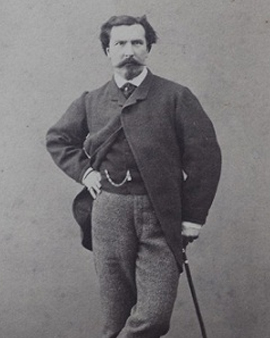Cristiano Banti, born in 1824 in Santa Croce sull'Arno, stands as one of the most significant figures in 19th-century Italian painting. His artistic journey is closely linked to the Macchiaioli movement, a group of Tuscan painters who rebelled against academic traditions and instead focused on the interplay of light and shadow, the so-called 'macchia', as the central element of their works. Banti began his career with historical and religious subjects, but soon, influenced by Giovanni Fattori and other Macchiaioli colleagues, he turned to plein air painting. The landscapes of Tuscany, rural life, and intimate everyday scenes became his favored motifs, which he captured with remarkable sensitivity to atmosphere and color.
His oeuvre is characterized by a subtle palette and masterful use of light, drawing viewers directly into the scene. Banti was not only a painter but also an important patron and supporter of the Florentine art scene. His home became a gathering place for artists and intellectuals who propelled the spirit of renewal in Italian art. Despite his success, Banti remained modest throughout his life and gradually withdrew from public life in his later years. His paintings, now found in renowned museums and available as high-quality art prints, reflect a longing for authenticity and the beauty of the everyday. Banti died in 1904 in Montemurlo, but his legacy as a pioneer of modern realism in Italy endures.
×





.jpg)
.jpg)
.jpg)
.jpg)
.jpg)
.jpg)
.jpg)
.jpg)
.jpg)
.jpg)
_oil_on_canvas_38x4_-_(MeisterDrucke-1103988).jpg)
_oil_on_canvas_38x4_-_(MeisterDrucke-1103988).jpg)
.jpg)
.jpg)
_-_(MeisterDrucke-1110772).jpg)
_-_(MeisterDrucke-1110772).jpg)
.jpg)
.jpg)
.jpg)
.jpg)
.jpg)
.jpg)
.jpg)
.jpg)
.jpg)
.jpg)
_oil_on_canvas_on_board_-_(MeisterDrucke-1104180).jpg)
_oil_on_canvas_on_board_-_(MeisterDrucke-1104180).jpg)
.jpg)
.jpg)
.jpg)
.jpg)
.jpg)
.jpg)
.jpg)
.jpg)
.jpg)
.jpg)
.jpg)
.jpg)
.jpg)
.jpg)
.jpg)
.jpg)
_oil_on_canvas_on_bo_-_(MeisterDrucke-1103657).jpg)
_oil_on_canvas_on_bo_-_(MeisterDrucke-1103657).jpg)
.jpg)
.jpg)
.jpg)
.jpg)
.jpg)
.jpg)
.jpg)
.jpg)
.jpg)
.jpg)
.jpg)
.jpg)






